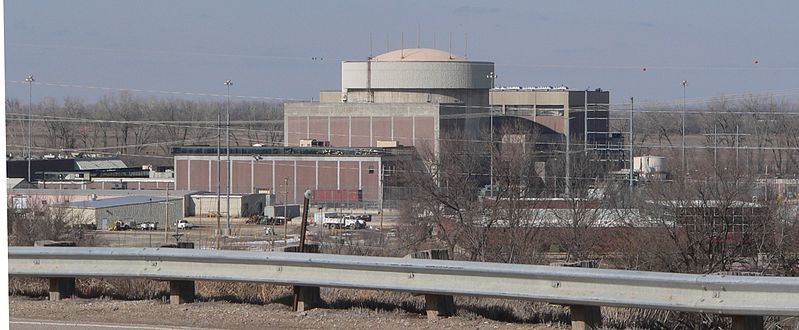The instant analysis following Donald Trump’s surprising defeat of Hillary Clinton in the Nov. 8 presidential election was that renewable energy would take a hit and fossil fuels would prosper. I think that is a vast over-simplification, but that is a topic for a later post. The question of the day is what will happen to the nation’s nuclear sector.
For the past several years, the Nuclear Energy Institute has worked tirelessly to broaden support for the industry by touting the technology’s importance in providing carbon-free electricity. And the industry has a valid point; the U.S.’ roughly 100 operating plants accounted for more than 60 percent of the nation’s emissions-free electric generation in 2015. According to NEI, nuclear generation avoided 564 million metric tons of carbon dioxide emissions last year, which it said is roughly equivalent to taking all the automobiles in the U.S. off the road.
In a carbon-constrained world, such as the one championed by President Obama and supported by Clinton, this would be important. Certainly, the nuclear industry was using it to drive support for subsidies for nuclear reactors challenged to operate profitably in competitive electric markets. In New York, for example, NEI strongly supported the development of the state’s zero emissions credit plan that is designed to keep three upstate reactors—the 576 megawatt Ginna plant, Nine Mile Point’s 640 MW Unit 1 and the 838 MW Fitzpatrick facility—operating well into the future despite their current inability to compete on price.
And NEI certainly doesn’t want to stop at New York’s borders. “The proposal [read: subsidies] developed by the staff could serve as a model for other states as they look to preserve non-emitting generation into the future,” NEI said this summer. “While a holistic policy that would allow consistency across states would be the ideal, New York is showing that states can take action before such a national framework is available.”
The need for subsidies came up again just two weeks before the election when the Fort Calhoun plant in Nebraska, the nation’s smallest operating nuclear reactor at 479 MW, closed, driven out of the market by unfavorable economics. NEI’s spin on that, delivered by Marvin Fertel, the group’s president and CEO, is a classic: “The premature closing of Fort Calhoun illustrates the situation in which well operating nuclear facilities are forced to shut down as a result of weak market conditions. This is especially the case with smaller, single-unit facilities in unregulated markets such as in Nebraska where economies of scale make it challenging to generate electricity at a competitive price.
“The negative impacts of its untimely closing make it clear there is an urgent need to prevent this from happening to other nuclear plants at risk of premature retirement. Without change, there will be more plant closings resulting in similar negative economic and environmental consequences.”
[As an aside, note the NEI caption on the photo below, obviously designed to make the pitch that closing the reactor is bad for the environment.]
 The closing of the Fort Calhoun nuclear power plant will remove 25 percent of the state’s carbon-free electricity from the grid.
The closing of the Fort Calhoun nuclear power plant will remove 25 percent of the state’s carbon-free electricity from the grid.
Returning to Fertel’s comments, what he is saying, in plain language, is that there are a number of other reactors that can’t compete and need subsidies to keep them open. There is no doubt those worries are real: One outside analyst, Bob Mancini, the head of the Carlyle Group’s power unit, has been widely quoted recently saying the industry is doomed without some form of support to keep existing reactors open and encourage the building of new facilities.
But what happens now, in an environment where both the president-elect and his vice president, Indiana’s Mike Pence, largely have dismissed concerns about climate change, with Trump saying flatly that he intends to “cancel” the U.S.’ participation in the recently negotiated Paris accord designed to curb CO2 emissions worldwide. Clearly if that happens, the U.S.’ own Clean Power Plan, now in legal limbo, won’t be needed either.
Then what?
Well, Robert McNally, an energy advisor to President George W. Bush and now president of the Rapidan Group, offered one opinion in a post-election Bloomberg story: “De-carbonization, which has been the organizing principle of Obama’s energy policy, came to a screeching halt last night.”
That might be a little over-the-top, but for the nuclear industry, which has largely sought to defend itself the past few years by stressing its importance in a de-carbonizing world, it has got to be a huge worry. The soon-to-be Trump administration isn’t likely to be swayed by appeals for subsidies to support uneconomic power if they are premised solely on the concept of safeguarding the generation of emissions-free electricity.
And unfortunately for the nuclear industry, the environmental argument may have been the only thing going for it. It’s interesting to note that in its 2016 Annual Energy Outlook released this spring, the Energy Information Administration projected that “even with the CPP in place” no new unplanned reactors would be built through the forecast period and the sector’s share of total electric generation would decline from current levels.
NEI will never say it, but the nuclear industry likely would have been much better off with a Clinton victory.
–Dennis Wamsted
 Follow
Follow
“NEI will never say it, but the nuclear industry likely would have been much better off with a Clinton victory.”
What evidence do you have that NEI endorsed Trump?